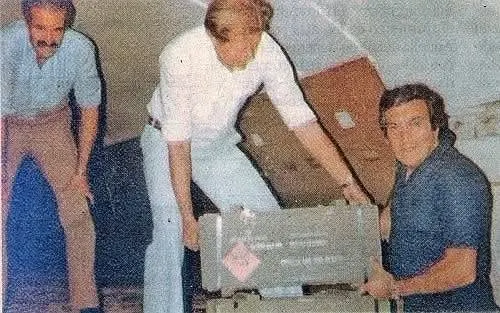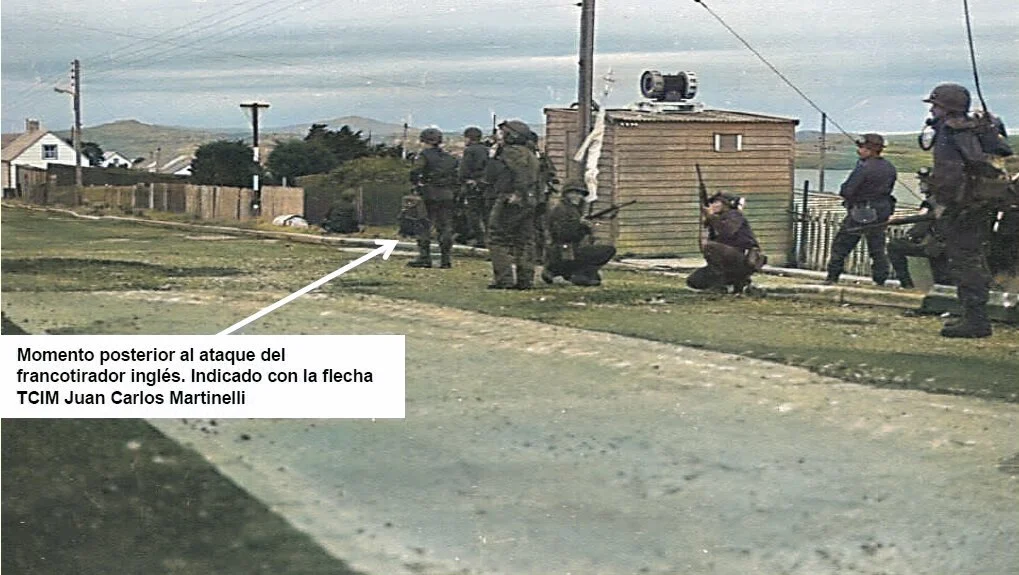Commander Carlos Robacio leads the 5th Marine Batallion 5 in Tumbledown
The 5th Marine Infantry Battalion from Río Grande stood alone against the onslaught of the Scots Guards at Mount Tumbledown, writing a glorious page in history.

During the 74 days of the Malvinas War, British forces were taken aback by the professionalism and fighting spirit of the Argentine troops. There is extensive British literature on the conflict, and all of it acknowledges the courage and resilience of our forces. One particular unit earned, from the British themselves, the nickname “Battalion from Hell” due to its valour and combat effectiveness. These men were the Marines of the 5th Marine Infantry Battalion (BIM 5).
On 7 April 1982, the personnel of BIM 5, based in Río Grande, arrived in the Malvinas under the command of Commander Carlos Robacio. The troops were deployed in the defensive system around Puerto Argentino, together with the Infantry Regiments RI 25 and RI 8. To reinforce the naval forces, Company C of RI 3 and Company B of RI 6 were also added. This integration of Army and Navy units was unprecedented and proved highly effective thanks to the professionalism and commitment of their officers.
From 1 May, the enemy began an aerial and naval bombardment campaign that severely affected the daily life of the Argentine soldiers. During the day, Harrier jets attacked the nearby airstrip and trench lines; at night, the Royal Navy carried out shelling. Despite this, the Marines maintained strong morale and continued to improve their defensive positions, preparing for the ground battle they knew was drawing near.
They endured 44 days of relentless siege. When fighting around Puerto Argentino began on 12 June, the marines of BIM 5 were ready to enter history. The British attack started at dusk and continued through the night. The first unpleasant surprise for the attackers was the presence of heavy machine gun nests equipped with infrared sights, which stalled their advance. Artillery exchanges followed, with the British enjoying an advantage thanks to their longer-range guns and greater mobility. Nevertheless, Argentine artillerymen fought with bravery and professionalism, firing until their last rounds, with barrels glowing red-hot.

On 13 June, the British launched their final offensive. They concentrated all their forces—paratroopers and Royal Marines—achieving a 3-to-1 numerical superiority over our Marines at the main breach. The artillery fire was intense, and naval artillery joined the barrage. Our own artillery, undeterred, responded at a rate of 1,000 rounds per hour, choosing to die on their feet rather than abandon their comrades.
In the late afternoon, the British attempted a flanking manoeuvre via Mount Harriet to distract the Argentine command. Robacio did not take the bait and instead set a deadly trap: he ambushed the enemy, pinning them between a minefield and artillery fire, while positioning Marines at their rear to block retreat. The outcome was heroic. The British were crushed by our artillery and infantry fire. Two hours later, the British company commander requested a ceasefire, citing the harrowing cries of the wounded as demoralising his troops. This ceasefire allowed the arrival of helicopters to evacuate the injured. No shots were fired at the helicopters, which were unarmed and clearly only conducting medical evacuation.
In the early hours of 14 June, the Scots Guards moved to the centre of the assault on Puerto Argentino. The firefight was intense. So many tracer rounds filled the sky that it seemed like daylight. In the final moments of the assault, the fighting became hand-to-hand. Argentine forces repelled the attack with fixed bayonets and requested artillery and mortar fire directly on their own positions, as the enemy had reached them. Second Lieutenant Silva and NCO Castillo called for a counterattack after being overrun. They left their positions and launched a bayonet charge until they were killed.
Commander Robacio personally led the counterattack, retaking lost positions and pushing the Scots Guards back to their original lines. By 3 a.m., amid a heavy snowfall, the Marines prepared another counteroffensive against the British paratroopers and requested authorisation as their forward units engaged the enemy. The order from Puerto Argentino was to withdraw, as it had become impossible to resupply 105 mm howitzers and mortars. Despite this setback, morale remained high, and it was difficult to convince the Marines to abandon their positions. With iron discipline, they withdrew from Mount Tumbledown and fell back.
A well-executed withdrawal under enemy pressure is one of the most difficult manoeuvres in military doctrine. History offers many examples of such withdrawals turning into deadly routs. But with pride, the Marines of BIM 5 took up new positions on the outskirts of Puerto Argentino, still determined to fight. Gurkha troops were dispatched to pursue the Argentines to make up for the Scots' poor performance, but they were halted and counterattacked—even though our men had run out of ammunition.
At dawn on Monday, 14 June 1982, BIM 5 had no ammunition left. In 36 hours, they had fired 17,000 artillery shells and all their mortar rounds. At 10 a.m., the ceasefire order came from Puerto Argentino. The battalion was still in combat formation. Commander Robacio requested confirmation of the order. His unit entered the capital of the islands in full marching formation, carrying all their personal weapons. Tragically, a section of the Navy Company that had been separated did not receive the order and at 12:30 engaged a landing of six British helicopters, shooting down two and suffering the loss of the last three Argentine soldiers in combat.
In military history, few units have endured 44 hours of bombardment without relief and then faced the enemy with such courage and determination. The Argentine forces at Tumbledown included 700 Marines and 200 soldiers, who confronted 3,000 of the best-trained troops of the British Armed Forces. Seventy-five per cent of our heroes were conscripts. BIM 5 suffered 30 killed and 105 wounded, inflicting an estimated 360 casualties on the enemy (a figure never officially recognised, though many British officers have acknowledged it privately).
How did they endure such hardship and fight with such determination? BIM 5 and RI 25 were the only units acclimatised to the Malvinas. They were well equipped, and their officers were professional and competent. They also shared a remarkable esprit de corps. As an example: on 14 June at 10:30, during the retreat to Sapper Hill, Commander Daniel Ponce collapsed from exhaustion. Amid gunfire, two conscripts rushed to carry him. Ponce ordered them to leave him and flee. Their reply: “Captain, if we die, we die together.” They lifted him and withdrew. That was the spirit of the marines of BIM 5, who gave everything for their country.



































